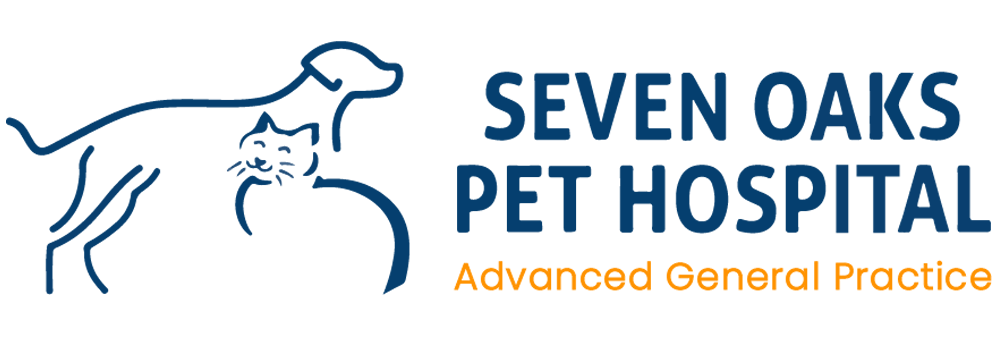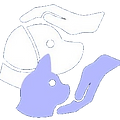Jaw Fractures Repair
To download and print this information, please click here.
Fracture of the Mandible in Dogs
- Fractures of the mandible (lower jaw) are usually the result of major trauma, especially to the head.
- Dogs can also develop non-traumatic fractures of the mandible when certain disease conditions exist. These fractures, also known as “pathologic fractures,” can occur if the dog has severe dental disease leading to the destruction of the bone supporting the teeth, is malnourished, has a systemic illness such as kidney disease, has an endocrine disorder such as hyperparathyroidism, has a bone infection (osteomyelitis) or has cancer of the bone. Symptoms caused by fracture of the mandible may be relatively subtle, with reluctance to play or chew on toys or food, or more obvious, with the inability to close the mouth, bloody saliva dripping from the mouth, or inability to eat at
- These fractures can occur at any location along the length of the bone from the midpoint where the two halves of the mandible meet in the front, back to the temporomandibular joint (TMJ). The fractures can occur on both sides of the jaw at the same time. Many of these fractures are “open” but occasionally “closed” fractures do occur.
- The mandible is one of the hardest bones in the body and a great deal of force is necessary to break the bone. Frequently the two halves of the mandible split at the midline (mandibular symphysis fracture). Also instead of a true fracture, the temporomandibular joints may dislocate (luxate) making the jaw non-functional.
- Mandibular fractures can also be categorized as “simple” or “comminuted.”
- Depending on the nature of the fracture and the age of the animal, different methods of repair may be indicated for each situation.
- Inappropriate case management, inadequate surgical stabilization, or poor aftercare can lead to complications such as non-unions (fractures that will not heal), malunions (fractures that heal in an abnormal direction or orientation resulting in malocclusion of the teeth and difficulty chewing), or osteomyelitis (bone infection).
- Mandibular fractures can have serious complications if not repaired or if the repair fails.
Symptoms:
- Drooling
- Inability to close the mouth
- Pain when the dog attempts to eat
Pre-Surgical Tests:
- Preoperative tests depend in part on the age and general health of the animal as well as the cause for the mandible fracture.
- Often a complete blood count, serum biochemical test, a urinalysis, and possibly an EKG will be performed prior to surgery.
Type of Anesthesia:
- General anesthesia is needed to induce unconsciousness, complete control of pain, and muscle relaxation.
- In the usual case, the pet will receive a pre-anesthetic sedative-analgesic drug to help him relax, a brief intravenous anesthetic to allow placement of a breathing tube in the windpipe, and subsequently inhalation (gas) anesthesia in oxygen during the actual surgery.
Diagnosis:
- A thorough physical examination including examination of the oral cavity. This may be suggestive of a mandibular fracture. Commonly found abnormal findings include broken teeth, disruption and hemorrhage from the gum line, jaw instability, crepitation (abnormal “crunchy” feeling with motion), swelling, and pain along the body of the mandible, or malocclusion (misalignment of the upper and lower teeth).
- Radiographs of the jaw. Several radiographic views of the animal’s jaw are used to confirm the diagnosis of mandibular fracture and may show luxation of the temporomandibular joints if present. Because most mandibular fractures are painful and most animals will not allow the jaw to be X-rayed while they are awake, anesthesia is usually necessary. Based on the location and severity of the fracture, a more informed discussion with the owner can occur regarding potential treatments, prognosis, and costs.
- Thoracic radiographs (chest X-rays). Chest trauma, in the form of pulmonary contusions (bruising) or pneumothorax (collapsed lung lobes secondary to free air within the chest cavity), must be ruled out with chest radiographs prior to anesthesia to repair the jaw.
- Complete orthopedic examination. A complete orthopedic examination must be performed to look for other possible injuries in other bones or joints caused by the trauma.
- A complete neurological examination. This is extremely important for an animal that has suffered trauma to the head. Damage to the brain and other important nerves in the head may result in temporary or permanent deficits that may need to be treated quickly and must be considered when planning a course of treatment for other injuries, such as a mandibular fracture.
Surgery:
- Emergency care for concurrent problems is the first part of treatment. Shock is a frequent result of major trauma and must be treated quickly.
- Depending on the specific fracture type, location, and age of the animal, mandibular fractures may be repaired in many different ways. Some fractures, especially those in a younger animal with a long nose that has not caused misalignment of the bone fragments or teeth may be managed with a “tape muzzle.” Symphyseal fractures are usually repaired with a single wire placed around the two halves of the jaw.
- Methods for surgical stabilization of other mandibular fractures include wires placed around the teeth, wires placed in the bone, bone plates and screws, and external fixators (pins holding the bone fragments stable through holes in the skin, like a scaffolding). Each of these methods may be used separately or in combinations to provide stability to the bone fragments while they heal. In some cases, the upper and lower jaws may be wired together or the upper and lower canine teeth may be temporarily cemented together to hold the fragments in position while the bones heal. These dogs may require the use of a feeding tube placed directly into the esophagus or stomach to allow nutrition and hydration without the need for chewing and swallowing.
- If dental disease is suspected as the cause for the fracture, a full dental cleaning with extractions of some teeth may be required.
- Injectable analgesics (pain medications) are given to the animal while being treated in the hospital and may be continued orally once discharged.
- Antibiotics are commonly given to minimize the chance for systemic infection from bacteria in the mouth.
Surgery Time:
- The procedure takes about 45 minutes to 1-1/2 hours to perform in most cases, including the needed time for preparation and anesthesia.
Risks and complications:
- The overall risk of this surgery is low. The major risks are those of general anesthesia, bleeding (hemorrhage), postoperative infection, and wound breakdown (dehiscence) over the incision.
- The overall complication rate is low, but serious complications can result in anesthetic death or the need for additional surgery.
Home Care and Prevention:
- After discharge from the hospital, the animal must be restricted from activity to allow the fracture time to heal properly.
- Activity must be restricted for several weeks after surgery; the duration will vary depending on the severity of the injury and any concurrent injuries the animal may have.
- Restricted activity means that the animal should be kept confined to a carrier, crate, or small room whenever he cannot be supervised.
- Playing and rough-housing should be avoided, even if he appears to be feeling well.
- It is especially important that dogs with mandibular fractures not be allowed to chew on toys or other objects and be fed only soft food or blenderized gruel.
- Animals whose fracture was repaired with an external fixation device will have pins exiting the skin. The “pin tracts” should be monitored daily for excessive swelling or discharge.
- Some discharge is normal and any crusty build-up that occurs at these sites can be gently cleaned with warm water.
- Fractures that are repaired with internal fixation (wires or bone plates and screws) will have a skin incision under the jaw that needs to be monitored daily for signs of excessive swelling or discharge. These can indicate problems with the incision or infection.
- The dog should be kept restricted from activity for several weeks and fed only a soft gruel that does not require chewing.
- Several 4-6 weeks after surgery a follow-up appointment will be needed. The jaw may need an X-ray again to make sure the bone is healing properly. If healing has occurred as expected, the external fixator, symphyseal wire, or other wires placed around the teeth will be removed and the animal’s activity level and diet will be allowed to return to normal.
- Many traumatic events are true accidents and thus unavoidable.
- Dental hygiene and routine cleaning by the veterinarian may prevent severe dental disease that could lead to mandibular fractures.



